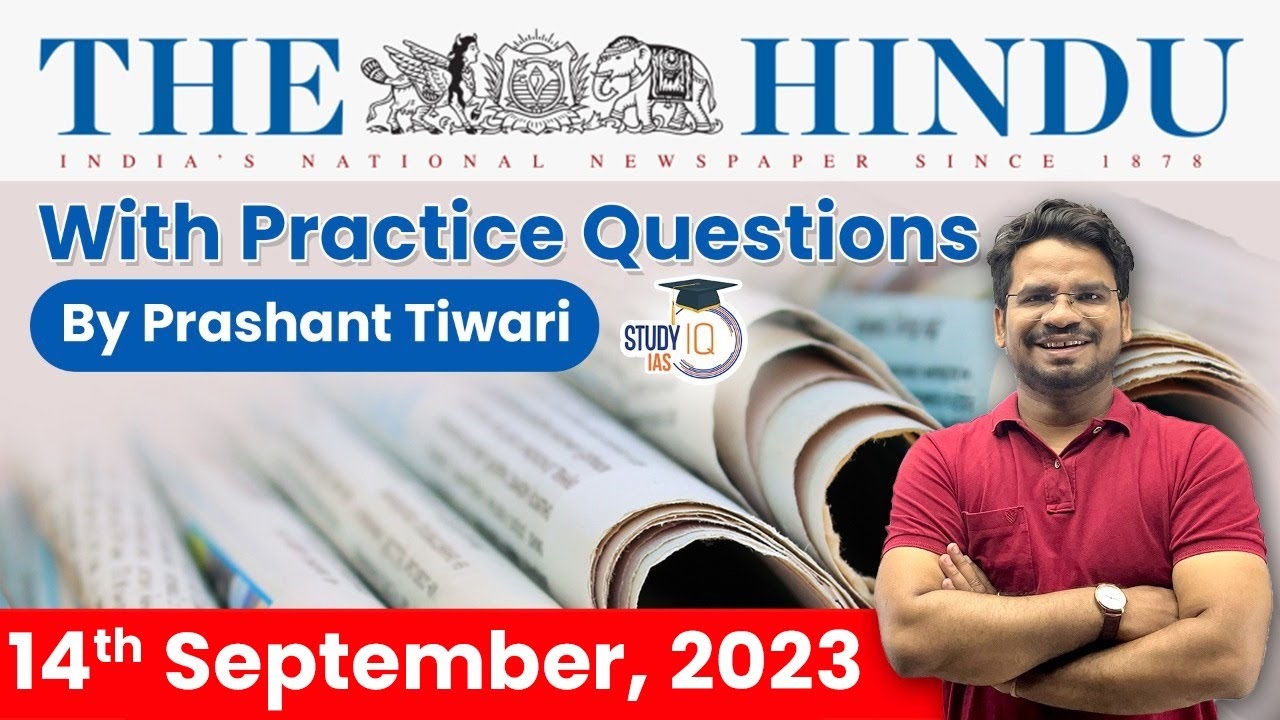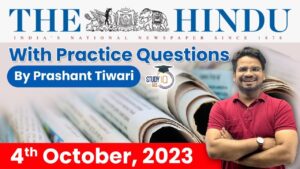The Hindu Newspaper Analysis for UPSC

The Hindu Newspaper Analysis 13 September 2023
- Gaps in teacher training
- News from schools regularly reminds us that the momentum generated by the Right to Education (RTE) Act that was enacted over a decade ago has subsided. The RTE had laid down indicators of quality, and for a while, an attempt was made in a few States to use RTE-compliance criteria for both government and private schools.
- The regulatory structure of the National Council for Teacher Education (NCTE) has not been able to enforce its meticulously worked out norms. In 2008, the Supreme Court of India appointed a commission under the late Justice J.S. Verma to examine the various ailments of teacher training. His magnificent report, submitted in 2012, offered some hope that the training of teachers would gain status and attention, but that hope proved short-lived.
- One of the many reports written since India’s Independence tried to spell out what might constitute appropriate professional conduct by adults who serve as teachers. This report is known as the Teacher Commission report. It was chaired by D.P. Chattopadhyaya.
- Teachers’ Day (September 5, the birth date of Dr. Sarvepalli Radhakrishnan, former President of India and statesman) ought to have reminded us that the nation gains little when it enfeebles the school teacher’s voice — individual and collective.

- For instance, for a transition to EVs, existing internal combustion engine (ICE) vehicles and the supporting infrastructure need to be replaced entirely, which is capital intensive. Further, the required batteries and critical minerals used in them need to be imported, adding to environmental concerns on how these minerals are mined, among other issues.
- Biofuels, on the other hand, can be used in existing ICE engines and infrastructure with little to no modifications (depending on the blending rates) and offer import independence.
- In India, biofuel is synonymous with first-generation (1G) ethanol, which is primarily sourced from food crops. The policy target in India of achieving 20% ethanol blending with petrol (E20) by 2025-26 is expected to be met almost entirely by 1G ethanol made from sugar cane and foodgrains.
- Second-generation (2G) ethanol, which is made from crop wastes and residues, is unlikely to contribute much to achieving this target due to several challenges related to feedstock supply chain and scaling up.
- The groundwater depletion implications of growing sugar cane are well known, but the food security implications of groundwater depletion and of using foodgrains for ethanol production are harder to imagine because India is currently a surplus food producer.
- First, India’s crop yields have already stagnated, and global warming is expected to reduce yields, which means that the same area under cultivation (arable land) will produce less with time but will need to suffice for a growing population. So, our strategy to meet blending targets cannot depend on surplus crop production.
- In India, the ethanol blending policy has been a good strategy to deal with the surplus sugar production.
- ‘Sustainable’ biofuels are produced from crop residues and other wastes, with low water and GHG footprint. The Global Biofuels Alliance that was formed at the G-20 Summit in New Delhi last week is expected to strengthen the development of sustainable biofuels, in addition to promoting ethanol uptake.
What are Biofuels?
- Any hydrocarbon fuel that is produced from an organic matter (living or once living material) in a short period of time (days, weeks, or even months) is considered a biofuel.
- Biofuels may be solid, liquid or gaseous in nature.
- Solid: Wood, dried plant material, and manure
- Liquid: Bioethanol and Biodiesel
- Gaseous: Biogas
- 1st generation biofuels are also called conventional biofuels. They are made from things like sugar, starch, or vegetable oil. Note that these are all food products. Any biofuel made from a feedstock that can also be consumed as a human food is considered a first-generation biofuel.
- 2nd generation biofuels are produced from sustainable feedstock. The sustainability of a feedstock is defined by its availability, its impact on greenhouse gas emissions, its impact on land use, and by its potential to threaten the food supply. No second generation biofuel is also a food crop, though certain food products can become second generation fuels when they are no longer useful for consumption. Second generation biofuels are often called “advanced biofuels.”
- 3rd generation biofuels are biofuel derived from algae. These biofuels are given their own separate class because of their unique production mechanism and their potential to mitigate most of the drawbacks of 1st and 2nd generation biofuels.
- 4th generation biofuels In the production of these fuels, crops that are genetically engineered to take in high amounts of carbon are grown and harvested as biomass. The crops are then converted into fuel using second generation techniques.

- It is a zoonotic virus (it is transmitted from animals to humans).
- The organism which causes Nipah Virus encephalitis is an RNA or Ribonucleic acid virus of the family Paramyxoviridae, genus Henipavirus, and is closely related to Hendra virus.
- Hendra virus (HeV) infection is a rare emerging zoonosis that causes severe and often fatal disease in both infected horses and humans.
- It first broke out in Malaysia and Singapore in 1998 and 1999.
- It first appeared in domestic pigs and has been found among several species of domestic animals including dogs, cats, goats, horses and sheep.
- Symptoms:
- The human infection presents as an encephalitic syndrome marked by fever, headache, drowsiness, disorientation, mental confusion, coma, and potentially death.
- Prevention:
- Currently, there are no vaccines for both humans and animals. Intensive supportive care is given to humans infected by Nipah virus.

- Any failure to anchor inflation will add to the risks to growth

- As the World Health Organization stated, “Floods are increasing in frequency and intensity, and the frequency and intensity of extreme precipitation is expected to continue to increase due to climate change.”
- As per the Geological Survey of India, over 40 million hectares, which is nearly 12% of the total land area of India, is prone to floods. The severity and frequency of floods has especially affected our cities, where there is little effort made in maintaining natural topography.
- Flooding affects the economy too — Indian cities are projected to contribute to 75% of the GDP by 2030.
- Illegal construction work in floodplains reduces the capacity of rivers to contain a high level of water within their banks. This is especially the case during heavy rainfall when water flows down from upper catchment areas.

- A plan to issue permanent disability certificates to those above the age of five with sickle-cell disease has been stuck in a quagmire at three Union Ministries for nearly three years. In a report tabled during the Monsoon Session of Parliament, a Standing Committee of Parliament urged the government to take a quick decision.
- Given that sickle cell disease, a debilitating genetic blood disorder, is especially prevalent among tribal populations across India, the Tribal Affairs Ministry is keen on ensuring that the certificates are issued to patients with chronic anaemia, pain, and complications arising out of tissue and organ damage.
- The Union government has been publicising its campaign to “eradicate” SCD in India by 2047.
- Tribal Affairs Minister Arjun Munda has been pushing for the issue of certificates. However, the Social Justice Ministry’s Department of Empowerment of Persons with Disabilities has said that the final call is with the Health Ministry, which is expected to put out its report on the issue in a month.
- When the disease was added to the list of disabilities under the Rights of Persons with Disabilities Act, 2016, patients could only get disability certificates with a one-year validity.
- The department eventually increased the validity of the certificates to three years, requiring a minimum of 25% disability. However, Mr. Munda once again communicated the need for permanent disability certificates because of the progressive nature of the disease.

- It is an inherited blood disorder.
- It affects hemoglobin, the molecule in red blood cells that delivers oxygen to cells throughout the body.
- People with this disease have atypical hemoglobin molecules called hemoglobin S, which can distort red blood cells into a sickle, or crescent, shape.
- These sickle cells also become rigid and sticky, which can slow or block blood flow.
- What causes it?
- The cause of Sickle cell disease is a defective gene, called a sickle cell gene.
- A person will be born with sickle cell disease only if two genes are inherited—one from the mother and one from the father.
- Symptoms:
- Early stage: Extreme tiredness or fussiness from anemia, painfully swollen hands and feet, and jaundice.
- Later stage: Severe pain, anemia, organ damage, and infections.
- Treatments:
- The only cure for this disease is bone marrow or stem cell transplantation.
- However, there are treatments that can help relieve symptoms, lessen complications, and prolong life.


 The Hindu Newspaper Analysis 6 October 2...
The Hindu Newspaper Analysis 6 October 2...
 The Hindu Newspaper Analysis 5 October 2...
The Hindu Newspaper Analysis 5 October 2...
 The Hindu Newspaper Analysis 4 October 2...
The Hindu Newspaper Analysis 4 October 2...





















